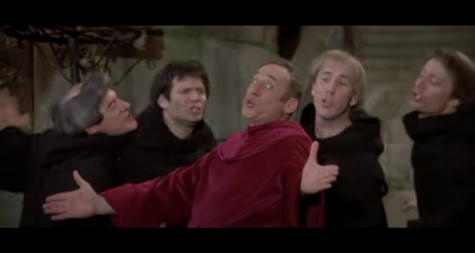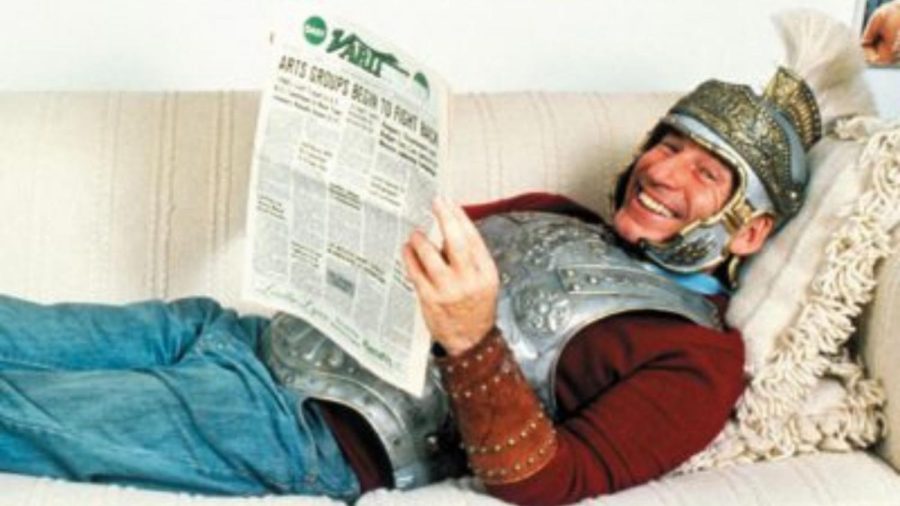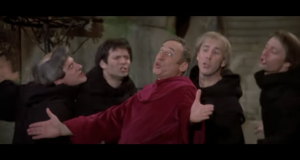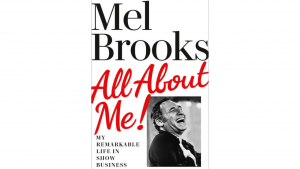Ranking Mel Brooks’ films from 11-to-1
A photo of Mel Brooks taken for Mademoiselle Magazine while Brooks was filming “History of the World: Part I” in 1980-81.
Published June 28, 2022
For many of us, especially those who grew up in the 1960s and 70s, Mel Brooks has always been something of an extended family member, the hilarious uncle we madly adore even though he never actually shows up for our weddings, seders or any other festive occasions.
Indeed, nothing sent a jolt of electricity through my childhood households quite like the phrase “new Mel Brooks movie.” This wasn’t just another entertainment option — this was an event, a rare visit from Uncle Mel that was sure to put a smile on your face and leave you quoting his latest jokes for weeks or even years to come. (Yes, my dad took me to see “Blazing Saddles” when I was seven, and yes that probably explains a lot about who I turned out to be. But I digress…)

I felt a brief flash of that old excitement last week, when word hit the streets that the 95-year-old comedy legend had inked a deal with Hulu to co-write and executive produce at least eight episodes of a new variety series called “History of the World, Part II,” based upon his 1981 film of (almost) the same name. But that initial buzz quickly dissipated once I remembered that, well, “History of the World, Part I” was actually pretty uneven — and that, by the time of his 90s films, Uncle Mel’s shtick was unfortunately wearing as thin as a cheap shmatta.
Still, I’m really hoping for (and wishing Uncle Mel) the best with his new series, because if there’s one thing this awful world could use, it’s a good dose of Mel Brooks-inspired silliness. And while we’re waiting for it to hit the small screen, let’s look back over the 11 films he wrote and directed, and rank ‘em from worst to best.
11. Life Stinks (1991)
In a plot that falls somewhere between “Trading Places” and “Sullivan’s Travels” — but without the biting wit of the former or the sly social commentary of the latter — Brooks plays a fabulously wealthy CEO who bets his rival (Jeffrey Tambor) that he can survive on the streets for 30 days. What follows is an unpleasant mixture of tiresome slapstick gags and grim scenes that attempt to convey (and occasionally squeeze some laughs from) the desperation of homelessness; only Brooks’ charming waltz sequence with Lesley Ann Warren (who plays a homeless dancer) injects any real light into the proceedings.
10. Dracula: Dead and Loving It (1995)
Brooks’ last directorial effort to date is also, sadly, one of his weakest. Spoofing the Dracula franchise a la “Young Frankenstein” would have been a promising idea, if only the 1979 George Hamilton disco-Drac flick “Love at First Bite” hadn’t already beat Brooks to the punch by a good 15 years. Leslie Nielsen and Brooks are agreeably hammy in their respective roles as Dracula and his nemesis Dr. Van Helsing, but the jokes are largely predictable and rarely rise above the level of mildly goofy. In other words, no fangs.
9. Robin Hood: Men In Tights (1993)
As one of the few viewers who genuinely loved Brooks’ 1975 Robin Hood-based sitcom “When Things Were Rotten” (ABC canceled it after half a season), I was pleased to see him return to Sherwood Forest 18 years later. Though it spoofs several scenes from specific Robin Hood films — especially 1991’s Kevin Costner vehicle “Prince of Thieves” — you don’t need to be familiar with them to enjoy this merry romp, though some patience may be required to sit through the musical numbers. The film wasn’t warmly received upon release, but it has developed a cult following over the years thanks in part to strong performances by Dave Chappelle and Richard Lewis, as well as hilarious appearances by Dom DeLuise (as the Godfather-esque Don Giovanni) and Brooks himself (as an itinerant Rabbi who specializes in bargain circumcisions).
8. History of the World, Pt. I (1981)
Though you can’t fault the guy for trying, Brooks definitely bit off more than he could chew with “History of the World, Pt. I,” a five-part anthology that explores the comedic possibilities of the Stone Age, the Old Testament, the Roman Empire, the Spanish Inquisition and the French Revolution. The gags miss as often as they hit, but the ones that do connect — like when Brooks’ Moses accidentally breaks the stone tablet emblazoned with Commandments 11-15 — are more than worth the price of admission. And if this is the third Brooks film to feature Madeline Kahn doing a penis-size bit, well, nobody ever riffed on penis size quite like Madeline Kahn.
7. High Anxiety (1977)
Ostensibly an Alfred Hitchcock parody, “High Anxiety” is really more of an homage to the legendary British director; after all, it’s difficult to spoof someone whose work is already filled with humor, even if Hitchcock’s laughs tended to be considerably darker than Brooks’. The script is funny and the cast (including such Brooks faves as Madeline Kahn, Cloris Leachman and Harvey Korman) is strong, but it’s the note-perfect nailing of Hitchcock’s camera and editing techniques that really makes the film such a pleasure to watch. Hitchcock himself was so impressed that he sent Brooks a case of expensive wine in salute.
6. Spaceballs (1987)
Released four years after “Return of the Jedi,” this “Star Wars” parody was pilloried at the time for being too late to the party, but its reputation has improved considerably over the last few decades. (I have personally interviewed at least five metal bands who can quote the film’s entire dialogue word-for-word.) If some of the gags are admittedly groan-worthy, the ones that fall flat are reliably upstaged by the copious belly laughs; for instance, “Dark Helmet” may be an uninspired spoof name for Darth Vader, but recasting Jabba the Hutt as the gross and greasy “Pizza the Hutt” remains a stroke of Brooksian genius. “Spaceballs” makes the most of a talented cast that includes Bill Pullman, John Candy, Rick Moranis (who gets some of the film’s best lines as the aforementioned Dark Helmet) and Daphne Zuniga, and is ultimately a lot more entertaining than any of the actual “Star Wars” films that came after it. Watch it, and the Schwartz will be with you!
5. The Twelve Chairs (1970)
Perhaps the most underrated entry in the entire Brooks filmography, “The Twelve Chairs” is an adaptation of a 1920s Russian novel of the same name involving the search for an Imperial fortune hidden in the cushion of a dining room chair. More melancholy and wryly humorous than laugh-out-loud funny, the film follows former aristocrat Ron Moody, roving con artist Frank Langella and corrupt priest Dom DeLuise as they desperately traverse the Soviet Republic in search of the chair and its jewels. Brooks has a great cameo as a drunken villager who pines for his pre-Revolution beatings, but it’s DeLuise who consistently steals the show; his hapless cry of “Oh, Lord… you’re so strict!” still echoes through my head on a weekly basis.
4. Silent Movie (1976)
Making a silent feature film about the making of a silent feature film was a pretty meta experiment even by Brooks’ self-referential standards, but “Silent Movie” actually works — and it’s so funny and well-paced that the novelty of the undertaking quickly recedes into the background. The film also simultaneously serves as both a celebration of the slapstick comedies of the Silent Era and a nose-tweak to the modern film industry; the latter aspect gets extra juice from silver screen icons Burt Reynolds, James Caan and Paul Newman, all of whom seem to enjoy the hell out of play exaggerated versions of themselves. But the film’s most memorable cameo goes to legendary mime Marcel Marceau, who of course delivers the silent film’s lone spoken line.
3. The Producers (1967)
When watching “The Producers” again for the umpteenth time, I never fail to be struck what a perfectly realized debut it is. Not only is it still screamingly funny, but so many of the elements that would mark Brooks’ later films are already in place: the Borscht Belt-tinged humor, the unlikely alliances (in this case, Zero Mostel’s blustery theatrical producer and Gene Wilder’s nebbishy accountant), the outrageous supporting characters, the production within the production, and of course the gleeful pushing of the boundaries of taste. “Springtime for Hitler” and the film’s mocking of Nazis still resonate (and provoke guffaws) nearly 55 years later, which was always the goal. “If I get on the soapbox and wax eloquently [about the Holocaust], it’ll be blown away in the wind,” Brooks explained in a 1978 interview. “But if I do ‘Springtime for Hitler’ it’ll never be forgotten.” Mission accomplished.
2. Young Frankenstein (1974)
Brooks’ and Gene Wilder’s horror parody so lovingly nails the look and atmosphere of Universal’s 1930s “Frankenstein” series that the film would be a joy even without Teri Garr’s Inga offering a literal “roll in ze hay,” Marty Feldman’s Igor revealing that he’s stolen the brain of one “Abby Normal,” or horses being spooked by the mere mention of Cloris Leachman’s Frau Blücher. The visual gags are just as strong as the verbal ones — who can forget Wilder and his monster Peter Boyle teaming up for a soft-shoe routine on “Puttin’ on the Ritz”? — and there’s also serious dramatic power in Wilder’s transformation from skeptical professor to mad scientist. But the most underrated bit might be Boyle’s soliloquy near the film’s end, in which the newly verbal monster charms the mob of pitchfork-toting villagers by praising Dr. Frankenstein for giving him “a calmer brain and a somewhat more sophisticated way of expressing myself.”
1.Blazing Saddles (1974)
Sure, it’s a parody of Hollywood westerns, and it’s loaded with scatological humor — but “Blazing Saddles” is so much more than all of that. Just as “Springtime for Hitler” did with the Nazis, the film takes on racism, the rape of the American West and the myth of Manifest Destiny by subjecting it (and its perpetrators) to merciless mockery; people who complain that the film “couldn’t be made today” tend to miss the fact that the screenplay’s racial slurs are largely uttered by, in the immortal words of Gene Wilder’s Waco Kid, “Simple farmers. People of the land. The common clay of the new West. You know, morons.” But there’s hope for better days ahead on the screen, as well; I mean, has there ever been a cooler interracial screen partnership than the Waco Kid and Cleavon Little’s Sheriff Bart? Or a sexier interracial screen pairing than Sheriff Bart and Madeline Kahn’s Lili Von Shtupp? Or a more uplifting celluloid example of Americans of all colors and creeds coming together than when the settlers, immigrants and former slaves join forces to save Rock Ridge from an army of bad guys? Throw in some authentic frontier gibberish, a cameo appearance by Count Basie, and the most iconic campfire farting sequence in cinematic history, and you really do have one of the greatest films ever made.



















